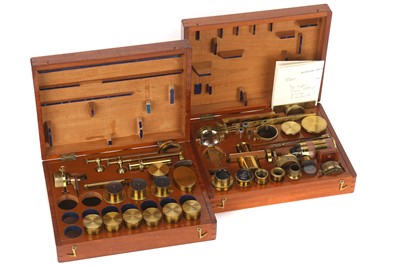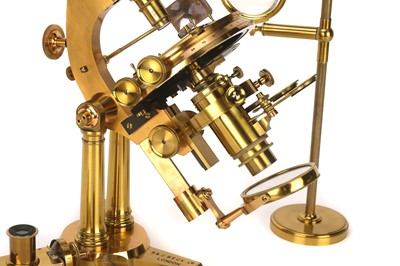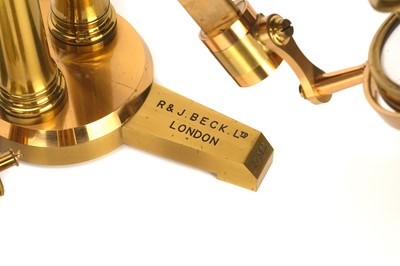21st May, 2020 12:00
Fine Photographica & Instruments of Science
A Large Smith & Beck No.1 Circuit Stage Binocular Microscope
A Large Smith & Beck No.1 Circuit Stage Binocular Microscope, English, dated 18 April 1899*, signed to the foot ‘R & J Beck Ltd LONDON’ and ‘N°21383’, the microscope stands on a flat tripod foot with two supporting pillars, architectural in style, both terminating in trunnions supporting the microscope body, with plano-concave mirror on swing-arm and sliding collar, sub-stage condenser holder with screw X & Y adjustment and rack-and-pinion focusing, a large circuit stage** allowing for full rotation of the specimen, stage with X & Y control, swept limb with single accessory holder, course focus to the top, fine focus mechanism acting on the rack, Wenham prism in pull out/in drawer, with two cases of accessories which contain:
the first case includes:
objectives all signed ‘Smith & Beck’, 3in, 2in, 11/2in, 1/5in, 2/3in/ 4/10in
A pair of medium power binocular eyepieces.
A high power eyepiece.
An achromatic condenser with a wheel of stops.
A stage bulls-eye.
A stage side reflector.
A Smith & Beck vertical illuminator in a can.
A side reflector in a can.
An erector lens and other items.
the second case includes:
A large live box.
two glass stages.
A compressor.
A large frog/fish plate.
Two Lieberkühns.
A dark well holder and three darkwells.
Stage forceps.
A Wenham-type parabolic condenser.
A large Ross eyepiece micrometer.
An Amici type prism.
An eyepiece lucida.
An iris.
A set of rotating selenite filters.
Various polarising accessories.
with large bullseye condenser in the main case, Substantial French polished mahogany cabinet with brass screwed joints and large brass carrying handle.
Note: with a bill of sales dated 29th March 1979 from Mayfair Microscopes Limited and signed by Brian Davidson
*From the Beck records.
** The circuit stage was an expensive optional extra for the No.1 microscope. It meant that the stage was further away from the limb of the microscope so it could be fully rotated, the limb is bigger as the body tube is also further out. This is a very rare feature.
Sold for £8,820
Result plus buyers premium
A Large Smith & Beck No.1 Circuit Stage Binocular Microscope, English, dated 18 April 1899*, signed to the foot ‘R & J Beck Ltd LONDON’ and ‘N°21383’, the microscope stands on a flat tripod foot with two supporting pillars, architectural in style, both terminating in trunnions supporting the microscope body, with plano-concave mirror on swing-arm and sliding collar, sub-stage condenser holder with screw X & Y adjustment and rack-and-pinion focusing, a large circuit stage** allowing for full rotation of the specimen, stage with X & Y control, swept limb with single accessory holder, course focus to the top, fine focus mechanism acting on the rack, Wenham prism in pull out/in drawer, with two cases of accessories which contain:
the first case includes:
objectives all signed ‘Smith & Beck’, 3in, 2in, 11/2in, 1/5in, 2/3in/ 4/10in
A pair of medium power binocular eyepieces.
A high power eyepiece.
An achromatic condenser with a wheel of stops.
A stage bulls-eye.
A stage side reflector.
A Smith & Beck vertical illuminator in a can.
A side reflector in a can.
An erector lens and other items.
the second case includes:
A large live box.
two glass stages.
A compressor.
A large frog/fish plate.
Two Lieberkühns.
A dark well holder and three darkwells.
Stage forceps.
A Wenham-type parabolic condenser.
A large Ross eyepiece micrometer.
An Amici type prism.
An eyepiece lucida.
An iris.
A set of rotating selenite filters.
Various polarising accessories.
with large bullseye condenser in the main case, Substantial French polished mahogany cabinet with brass screwed joints and large brass carrying handle.
Note: with a bill of sales dated 29th March 1979 from Mayfair Microscopes Limited and signed by Brian Davidson
*From the Beck records.
** The circuit stage was an expensive optional extra for the No.1 microscope. It meant that the stage was further away from the limb of the microscope so it could be fully rotated, the limb is bigger as the body tube is also further out. This is a very rare feature.
Auction: Fine Photographica & Instruments of Science, 21st May, 2020






